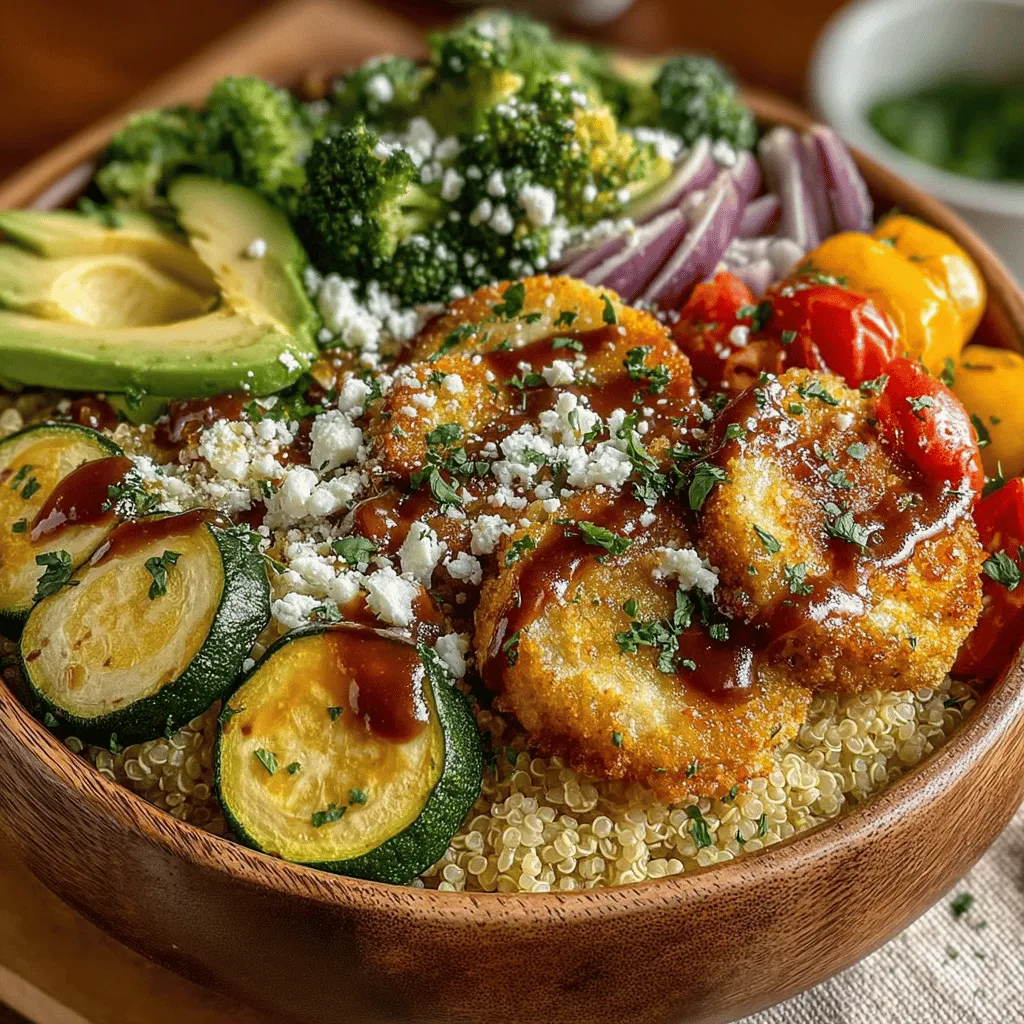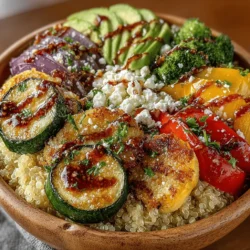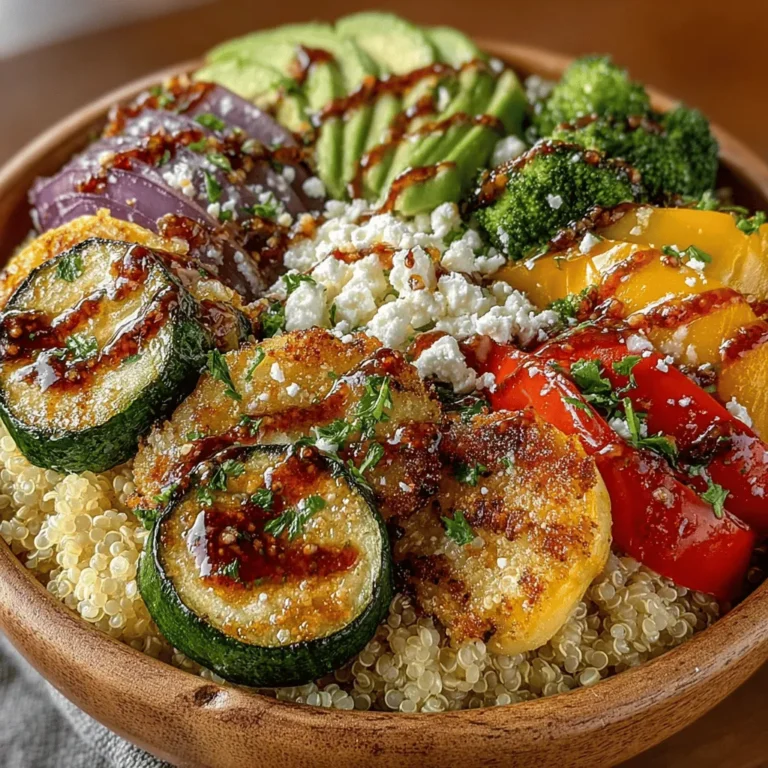Quinoa and Roasted Veggie Power Bowls: A Nutritious Meal Option
In recent years, power bowls have emerged as a popular meal choice among health enthusiasts and busy individuals alike. These hearty bowls combine a variety of wholesome ingredients that come together to create a nourishing dish, perfect for any time of the day. The versatility of power bowls allows them to cater to a wide range of dietary preferences, making them an ideal option for everyone—from vegetarians to gluten-free eaters. Among the myriad of power bowl combinations, quinoa and roasted veggie power bowls stand out for their vibrant flavors, nutritional density, and ease of preparation.
Quinoa, often touted as a superfood, serves as the base for this power bowl, providing not only a satisfying texture but also a wealth of health benefits. When paired with a colorful array of roasted vegetables, such as zucchini, bell peppers, cherry tomatoes, red onion, and broccoli, these bowls become a powerhouse of nutrients. The combination of these ingredients ensures that you’re not only indulging your taste buds but also nourishing your body. The appeal of this recipe lies in its delectable flavors, impressive nutritional profile, and the simplicity of preparation, making it accessible for anyone looking to whip up a healthy meal.
Understanding the Ingredients
The Nutritional Benefits of Quinoa
Quinoa is often referred to as a “complete protein” because it contains all nine essential amino acids that the human body cannot produce on its own. This makes it an excellent protein source for vegetarians and vegans. In addition to its protein content, quinoa is rich in dietary fiber, which promotes digestive health and helps to maintain a feeling of fullness. Incorporating quinoa into your diet can also support heart health, as it is low in fat and cholesterol-free. Furthermore, quinoa is gluten-free, making it a fantastic alternative for those with gluten sensitivities or celiac disease.
Roasted Vegetables: A Nutritional Powerhouse
The choice of vegetables in this recipe adds not only vibrant colors but also a plethora of health benefits:
– Zucchini: This low-calorie vegetable is mostly composed of water, making it hydrating and an excellent choice for weight management. Zucchini is also a good source of vitamins A and C, both of which are essential for skin health and immune function.
– Bell Peppers: Known for their bright colors, bell peppers are rich in vitamins A and C, as well as antioxidants. Vitamin C is crucial for collagen production and boosts the immune system, while vitamin A is important for eye health.
– Cherry Tomatoes: These bite-sized fruits are packed with antioxidants, particularly lycopene, which has been linked to reduced risk of heart disease and cancer. Their natural sweetness, intensified through roasting, adds a delightful burst of flavor to the bowl.
– Red Onion: Besides providing a pungent flavor, red onions contain quercetin, a powerful anti-inflammatory compound. They also add a crunch to the dish and are high in vitamins and minerals that support overall health.
– Broccoli: This cruciferous vegetable is known for its immune-boosting properties, thanks to its high levels of vitamins C, K, and various antioxidants. Broccoli is also a good source of fiber, which aids in digestion and promotes a healthy gut.
Enhancing Flavor and Nutrition
To elevate the flavors in your quinoa and roasted veggie power bowls, we use olive oil, garlic powder, and smoked paprika. Olive oil is not only a heart-healthy fat but also enhances the absorption of fat-soluble vitamins from the vegetables. Garlic powder adds a subtle garlic flavor that complements the natural sweetness of the roasted veggies, while smoked paprika provides a smoky depth that makes the dish more complex and satisfying.
For those looking to add a touch of richness, optional ingredients like feta cheese or tahini can be included. Feta cheese brings a tangy creaminess that pairs beautifully with the roasted flavors, while tahini adds a nutty richness and creamy texture, enhancing the overall taste of the bowl.
Preparation Steps: A Detailed Walkthrough
The first step in creating your quinoa and roasted veggie power bowls is to preheat your oven. Preheating is crucial for roasting vegetables because it ensures that they cook evenly and develop that desirable caramelized flavor. A temperature of about 425°F (220°C) is ideal for roasting, as it allows the vegetables to brown nicely while retaining their natural sweetness and nutrients.
Once the oven is preheated, you can move on to preparing your ingredients. Begin by rinsing your quinoa under cold water to remove any bitterness. Following this, cook the quinoa according to package instructions; typically, this involves a simple ratio of 1 part quinoa to 2 parts water, bringing the mixture to a boil, then simmering until fluffy.
Next, while the quinoa cooks, you can wash and chop your vegetables into bite-sized pieces. Aim for uniform sizes so that they roast evenly. After chopping, toss the vegetables in a bowl with olive oil, garlic powder, smoked paprika, salt, and pepper until they are well-coated. This step not only enhances their flavor but also helps to achieve that perfect roasted texture.
Spread the seasoned vegetables in a single layer on a baking sheet lined with parchment paper. This allows for even roasting and prevents sticking. Once the oven is ready, place the baking sheet inside and roast the vegetables for about 20 to 25 minutes, or until they are tender and slightly charred, stirring halfway through to ensure even cooking.
As the vegetables roast, your quinoa should be nearly done, absorbing all the water and fluffing up beautifully. Once both components are ready, you can begin assembling your power bowls, layering the quinoa as the base and topping it with the colorful roasted veggies.
Stay tuned for the next part of this recipe, where we will delve deeper into the final touches, garnishes, and serving suggestions to make your quinoa and roasted veggie power bowls truly shine.

Preparing the Quinoa
Quinoa, a nutrient-dense grain, is the base of our power bowl. To ensure you achieve perfectly cooked quinoa, follow these step-by-step instructions:
1. Rinse the Quinoa: Start by placing 1 cup of quinoa in a fine-mesh strainer. Rinse it thoroughly under cold running water for about 30 seconds to remove the natural coating called saponin, which can impart a bitter flavor.
2. Cook the Quinoa: In a medium saucepan, combine the rinsed quinoa and 2 cups of vegetable broth. Using vegetable broth instead of water significantly enhances the flavor of the quinoa, adding depth and richness to your dish. Bring the mixture to a boil over medium heat.
3. Simmer and Fluff: Once boiling, reduce the heat to low, cover the pot, and let it simmer for about 15-20 minutes or until the quinoa has absorbed all the liquid and appears fluffy. Remove it from the heat and let it sit covered for an additional 5 minutes. Finally, fluff the quinoa with a fork for a light, airy texture.
Roasting the Vegetables
Roasting brings out the natural sweetness and enhances the flavors of vegetables. Here’s how to prepare and season them:
1. Choose Your Vegetables: Select a mix of your favorite veggies. Bell peppers, zucchini, carrots, and broccoli work wonderfully together. Aim for about 4 cups of chopped vegetables.
2. Preheat the Oven: Preheat your oven to 425°F (220°C). A hot oven is crucial for achieving that desirable caramelization.
3. Season the Vegetables: In a large bowl, toss the chopped vegetables with 2 tablespoons of olive oil, 1 teaspoon of salt, and 1 teaspoon of black pepper. Add spices like garlic powder, paprika, or cumin for extra flavor if desired.
4. Spread Evenly: Lay the seasoned vegetables in a single layer on a baking sheet lined with parchment paper. Avoid overcrowding the pan, which can lead to steaming instead of roasting.
5. Roast to Perfection: Roast the vegetables for 20-25 minutes, flipping them halfway through to ensure even cooking. They should be tender and slightly charred when done.
Tips for Even Roasting and Caramelization
– Uniform Size: Cut your vegetables into similar sizes to ensure they cook evenly.
– Use Parchment Paper: This prevents sticking and aids in easy cleanup.
– Don’t Overcrowd: If you have a lot of vegetables, consider roasting them in batches to allow for proper airflow and caramelization.
Assembling the Bowls
Once the quinoa and vegetables are ready, it’s time to assemble your power bowl:
1. Start with Quinoa: Place a generous scoop of cooked quinoa at the bottom of your bowl. Aim for about 1 cup, as this will serve as a hearty base.
2. Layer the Vegetables: Add a mix of the roasted vegetables on top of the quinoa. Consider arranging them in sections for a visually appealing presentation.
3. Add Additional Ingredients: For extra nutrition and flavor, consider adding toppings such as avocado slices, a handful of fresh greens, or a sprinkle of nuts and seeds.
Visual Appeal and Layering of Ingredients
Layering not only enhances the aesthetic of your power bowl but also creates a balanced meal. Aim to include a variety of colors and textures. For instance, the bright orange of roasted carrots, the green of zucchini, and the earthy tones of quinoa create a vibrant and inviting dish.
Garnishing and Serving
The final touches are essential for elevating your power bowl:
1. Fresh Herbs: Sprinkle fresh herbs like cilantro or parsley over the top for a burst of flavor and color.
2. Dressings: Drizzle your favorite dressing, such as a tahini sauce, balsamic vinaigrette, or a zesty lemon-tahini dressing, over the assembled bowl for added moisture and flavor.
3. Serve Immediately: Enjoy your bowls while the quinoa and veggies are warm. This dish is also perfect for meal prep, as the components can be stored separately in the refrigerator and assembled when ready to eat.
Nutritional Information Breakdown
Quinoa and Roasted Veggie Power Bowls are not just delicious; they are also packed with nutrients. Here’s a breakdown of the nutritional information per serving (approximately 1 bowl):
– Calories: 450
– Protein: 12g
– Carbohydrates: 70g
– Fat: 15g
– Fiber: 10g
Vitamins and Minerals
This power bowl is loaded with essential vitamins and minerals, including:
– Vitamin A: From roasted carrots and bell peppers, supporting eye health.
– Vitamin C: Present in bell peppers and broccoli, boosts the immune system.
– Iron: Quinoa is a complete protein and provides iron, essential for energy levels.
Dietary Compatibility
This recipe is versatile and aligns with various dietary plans:
– Vegan and Vegetarian: It’s entirely plant-based.
– Gluten-Free: Quinoa is naturally gluten-free, making this dish suitable for those with gluten sensitivities.
Variations and Customizations
One of the best aspects of Quinoa and Roasted Veggie Power Bowls is their adaptability. Here are some ideas to customize your bowls:
– Seasonal Vegetables: Use whatever vegetables are in season for the freshest flavors. Consider asparagus in the spring or butternut squash in the fall.
– Protein Additions: Boost the protein content by adding chickpeas, black beans, or grilled chicken. Tofu or tempeh are excellent plant-based options as well.
– Alternative Grains: If you’re looking to mix things up, substitute quinoa with brown rice, farro, or even bulgur for different textures and flavors.
– Sauces and Dressings: Experiment with various dressings to find your favorite flavor combination. Try a spicy chili sauce for kick, or a creamy avocado dressing for richness.
Conclusion
Creating Quinoa and Roasted Veggie Power Bowls is a simple yet rewarding experience that celebrates wholesome ingredients and vibrant flavors. This dish is not only nourishing but also highly versatile, making it perfect for meal prep or a family dinner.
Encourage experimentation with different vegetables, proteins, and dressings to tailor the bowls to your preferences. With endless possibilities, you can enjoy a bowl that suits your taste while reaping the health benefits of this nutrient-packed meal. So gather your ingredients, embrace your creativity, and savor the deliciousness of these power bowls!


